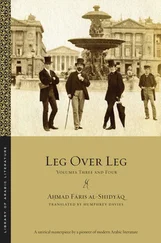0.2.4
Thus, among the characteristic associations of the letter ḥ , for example, are amplitude and expansiveness, as in the words ibtiḥaḥ (“affluence and abundance”), badāḥ (“broad tract of land”), barāḥ (“broad uncultivated tract of land”), abṭaḥ (“wide watercourse”), iblindāḥ (“widening out (of a place)”), jaḥḥ (“leveling out (of a thing)”), raḥraḥ (“wide and spread out”), murtadaḥ (“scope, freedom”), rawḥ (“breeze”), tarakkuḥ (“spaciousness”), tasṭīḥ (“roof-laying”), masfūḥ (“spreading (of water)”), masmaḥ (“ample room”) as in the saying “Keep thou to the truth, for in it is ample room, i.e., space,” 8 sāḥah (“courtyard”), insiyāḥ (“bigness of belly”), shudḥah (“roominess”), sharḥ (“laying open”), ṣafīḥah (“slab of stone”), ṣaldaḥ (“wide stone”), iṣlinṭāḥ (“widening out (of a valley)”), muṣalfaḥ (“large-headed”), ṭaḥḥ (“spreading”), mufalṭaḥ (“large-headed”), fashḥ (“standing astraddle”), faṭḥ (“broadening”), falṭaḥah (“flattening”), and so on to the end of that rubric. To these may be added numerous words whose connection to the idea of amplitude and expansiveness is not obvious and can be detected only with careful scrutiny, such as sujāḥ (“air”), tasrīḥ (“divorce”), samāḥah (“generosity”), and sunḥ (“good fortune and blessing”).
0.2.5
Among characteristic associations of the letter d are softness, smoothness, and tenderness, as in the words burakhdāh (“a smooth, limp woman”), tayd (“kindness”), thaʾad (“soft, tender plants”), thaʿd (“soft dates”), muthamʿidd (“clear-faced (of a boy)”), muthamghidd (“fatty (of a kid)”), thawhad (“fat and well-formed (of an adolescent boy)”), thahmad (“large and fat”), khabandāh (“fat and full (of a woman)”), khawd (“young and well-formed (of a girl)”), raʾdah (“early matured due to good nourishment (of a girl)”), rakhwaddah (“soft (of a woman)”), rahādah (“softness and pliancy”), ʿubrud (“white and soft (of a girl)”), furhud (“plump and handsome (of an adolescent boy)”), umlūd (“soft and pliable”), fulhūd (“fat and comely (of a youth)”), qurhud (“smooth, fleshy, and soft”), qishdah (“clotted cream”), maʾd (“large and fat”), murd (“boys with downy upper lips but no beards”), maghd (“smooth and fleshy”), malad (“youthfulness, softness, and wobbliness”), and so on to the end of the rubric. To these may be added, under the heading of figurative usages, such words as raghd (“generous and kindly”), sarhadah (“ease of living”), majd (“glory, generosity”), and so on.
0.2.6
It may be that the ancient Arabs sought to bring a balance to certain letters or, in other words, took care to give the opposite meaning full play too, for the letter d also encompasses many words indicating hardness, strength, and force, as in taʾaddud (“harshness”), taʾkīd (“asserting”), taʾyīd (“confirming”), jalʿad (“hard and strong”), jalmad (“a rock”), jamad (“ice”), ḥadīd (“iron”), suḥdud (“strong and rebellious”), sukhdūd (“a man of iron”), samhad (“a thing hard and dry”), tashaddud (“harshness, severity”), ṣafad (“shackle”), ṣald (“hard and smooth”), ṣalkhad (“a tall, strong, aged camel”), ṣimaghd (“hard”), ʿajrad (“thick and strong”), taʿajlud (“to grow large and strong”), ʿard (“erect, strong, and hard”), ʿirbadd (“strong”), ʿarqadah (“to twist tightly”), ʿaṣlad (“strong and hard”), ʿaṭawwad (“harsh and difficult”), ʿaṭarrad (“4harsh and difficult”), ʿald (“hard and strong”), and so on.
0.2.7
Among the characteristic associations of the letter m are cutting, uprooting, and breaking, as in the words arama (“to seize and bite”), azima (“to bite hard using the whole of the mouth”), tharima (“to be gap-toothed”), thalama (“to nick or notch (a blade or the like)”), jadhama (“to chop off”), jarama (“to bone (meat)”), jazama (“to cut short”), jalama (“to clip”), ḥadhama (“to cut quickly”), ḥadhlama (“to sharpen to a point”), ḥasama (“to sever”), ḥaṭama (“to smash”), ḥalqama (“to cut the throat of (s.o.)”), khadhama (“to cut”), kharama (“to pierce”), khazama (“to thread (pearls)”), khaḍama (“to bite into (s.th.)”), and so on to the end of the rubric. To these may be added, under the heading of figurative usages, ḥumma meaning “it (a certain matter) was decreed,” ḥaruma (“to be forbidden”), ḥatama (“to declare necessary”) and ḥazuma (“to be resolute”), in all of which the sense of “cutting” is clearly observable. Also common in this letter are the meanings “darkness” and “blackness.”
0.2.8
Among the characteristic associations of the letter h are stupidity, heedlessness, and rathʾ , or lack of native wit, examples being aliha (“to be perplexed”), umiha (“to become demented”), baliha (“to be stupid”), būhah (“a stupid, inconstant, and disordered man”), tafiha (“to become stupid”), tawh (“disturbance of the mind”), dalh (“being maddened by love”), sabah (“senile dementia”), shudiha (“to become amazed and confused”) (a dialectal variant of duhisha , or formed from it by metathesis), ʿutiha (“to lose one’s mind”), ʿaliha (“to become confused and amazed”), ʿamiha (“to hesitate as though lost and confused (in an argument or on a road)”), namiha (“to become somewhat confused”), and wariha (“to become stupid”). It is the same with the rest of the letters.
0.2.9
Another oddity of the language is that certain patterns are associated with a specific meaning, examples being ijrahadda (“to hasten one’s pace when walking”) and ismaharra (“to become hard and strong”). 9
0.2.10
All these things are alluded to in this book and must be quickly grasped. I have perused what Imam al-Suyūṭī 10(God show him mercy) has to say on the distinguishing characteristics of the language in his Al-Muzhir fī l-lughah ( The Luminous Work on Language ), 11copying from the master linguist Ibn Fāris, 12and found that it fails to deal at any length with this type of association of form and sense; even worse, it sometimes seems to provide examples of “associations” that shouldn’t be considered as such — for example, the application of the term ḥimār (“donkey”) to a dim-wit. 13
0.2.11
Читать дальше












